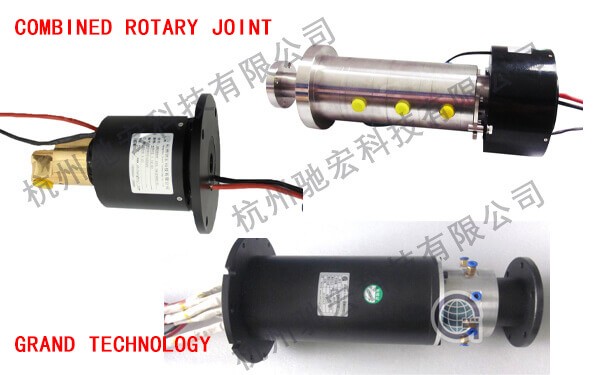Welcome to this insightful exploration of mechanical engineering – a world where moving parts, precise dimensions, and the right components can make drastic differences in functionality. Within this sphere, two essential components often enter the conversation when it comes to the transmission of signals and power where constant rotation is required – slip rings and rotary joints.
Each device, while similar in some respects, has unique attributes and functionalities that set them apart. Slip rings, under the umbrella of electrical engineering, typically exist to transfer electrical power or signals from a stationary source to a rotating object, uninterrupted even by constant full-circle movement. On the other hand, rotary joints, a masterpiece of mechanical engineering, facilitate the passage of fluid under conditions of pressure or vacuum from a stationary line into a rotating part.
Blending intricate engineering concepts with practical applications, this article aims to unravel the profound contrast between slip rings and rotary joints, setting each apart in the mechanical engineering landscape. Over the forthcoming sections, we will dissect the structural, functional, operational, and performance-related nuances of both devices. We’ll then explore the unique scenarios that dictate the choice between slip rings and rotary joints, aiding in streamlining decisions for specific applications.
Through a comparative analysis filled with detailed observations, this article seeks to guide those operating in fields such as robotics, aeronautics, automation, and other industries marked by rotational mechanisms. For engineers, mechanical enthusiasts, and decision-makers, this guide will serve to demystify these devices and help tailor the best decisions for each operative context. In our quest to understand these complex components, we will navigate a comprehensive exploration of their operation, applications, and considerations affecting their choice.
Introduction to Slip Rings
Navigating from general terms to specific, it’s important to focus our lens on a cornerstone of rotational mechanics – the slip ring. Often referred to as rotary electrical interfaces, slip rings do not merely exist; they perform a vital function enabling continuity and functionality in an array of systems.
Essentially, a slip ring is an electromechanical device that assists in the transmission of power and electrical signals from a stationary structure to a rotating assembly. It functions as a crucial pivot point, making uninterrupted communication possible even in environments where unceasing spinning movement is the norm.
Much like an orchestra, each part of the slip ring plays its role harmoniously to allow it to function seamlessly. The working principle of a slip ring is founded on touch technology. It comprises two main components – the brushes and rings. The brushes are metal or graphite structures that slide or rotate on the rings, forming an electrical connection. The rings, made typically of copper or other conductive materials, are connected to the rotating part of the device. As the rotation occurs, the brushes maintain their point of contact with the rings, resulting in a steady flow of electric current or transfer of electrical signals, despite the rotational movement.
The versatility and adaptability of slip rings theoretically know no bounds. With their ability to facilitate complex mechanical operations, different types of slip rings have been crafted to meet a plethora of applications. For instance, conventional electrical slip rings are often utilized in generators, rotating tanks, helicopters, and wind turbines. Fiber optic slip rings, often referred to as FORJs, are employed in high-speed data transmission scenarios such as HD video broadcasts or radar devices. In highly demanding environments requiring utmost precision and minimal friction, like magnetic resonance imaging (MRI) machines, capsule or pancake slip rings come into play.
Each type of slip ring, catering to distinct environmental and functional requisites, exhibits the versatility of this unique piece of engineering. Recognizing the varying applications of these different slip rings helps users choose the right device for their specific scenario, consequently enhancing efficiency and performance.
Introduction to Rotary Joints
As we continue our exploration of mechanical marvels, the spotlight now falls upon another fundamental player in rotational mechanics – the rotary joint. Also referred to as rotary unions or swivels, these components form an integral part of many applications that demand the transfer of fluid from a static point to a rotating component.
In essence, the rotary joint is a precise and intricate device that creates a reliable seal between a stationary pipeline and a rotating assembly. It permits the regulated flow of fluids – including liquids, gases, and even steam – under various conditions of pressure or vacuum.
Like a well-conducted symphony, each part of a rotary joint is critical to its successful operation. Within its intricate design, several components synergistically ensure its functionality. The working principle of a rotary joint involves a stationary inlet to pipe the input fluid and a rotating outlet connected to the receiving part, effectively facilitating a rotating seal. Its core components encompass seals and bearings; the former prevents the fluid’s leakage from the stationary to the rotating part, while the latter allows for smooth and stable rotary motion.
Unsurprisingly, rotary joints have found a stronghold in countless industrial operations due to their unyielding reliability and versatile functionality. Different types of rotary joints cater to a vast range of industry applications. Elastomer-sealed rotary joints are often deployed in printers, paper machines, and textile production due to their resistance to high temperatures. For industries handling air, vacuum, and hydraulic fluid, such as clamping technology or vacuum handling, metal-sealed rotary joints form the equipment of choice. In operations under extreme conditions – like semiconductor manufacturing, cutting-edge scientific research, and military applications – special rotary joints have been designed to meet these unique requisites.
Reading between the lines of these varied applications, the real-world implications of rotary joints extend far beyond what a person might initially conceptualize. Their diversity of purpose, borne out of careful design and precise manufacturing, leverages a great deal of functionality, making them an essential factor in many industrial processes.
Comparisons between Slip Rings and Rotary Joints
As we navigate the purview of slip rings and rotary joints, the relationship between their physical structure, function, operation, performance, and capability to tolerate varied conditions paints a vivid picture of comparison and contrast. Here we attempt to unravel these unique perspectives.
Slip Rings vs. Rotary Joints: Structural Differences
Even a cursory glance demonstrates the stark differences between slip rings and rotary joints. The simplicity of a slip ring lies in its elemental design which chiefly involves brushes and rings. The physical structure of the brushes sliding or rotating on the rings allows them to relay power and signals in the rotation, thereby highlighting their functionality as an electrical medium.
A rotary joint, on the other hand, presents a more complex design. It normally incorporates numerous operational elements including bearings, seals, and sometimes, even an internal shaft. The seals create a guarded pathway for fluid, while the bearings facilitate rotational movement – a succinct representation of its mechanical nature.
These contrasting structural designs directly shape their respective functionalities, with slip rings nestling comfortably in the realm of electrical transmission and rotary joints in the domain of fluid conveying.
Slip Rings vs. Rotary Joints: Functional Differences
As the saying goes, form follows function, and in no way is this more evident than in slip rings and rotary joints. Slip rings specialize in the transmission of electric signals and power, ensuring a continuous flow of electricity or data signals irrespective of the degree or speed of rotation, making them the guiding star in electromechanical systems.
Rotary joints, however, follow a different compass, dedicated to the passage of fluids – encompassing steam, thermal oils, water, and gases – from a stationary structure to the continuously rotating part. This inherent differential signals their ideal usage in varied applications.
Slip Rings vs. Rotary Joints: Operational Differences
Operating and maintaining these devices introduces further distinctions. The operation of a slip ring calls for enlisting adequate contact between brushes and rings, while its upkeep primarily involves routine inspection of brushes and replacement when worn out.
Conversely, rotary joints focus on maintaining a flawless seal and stable rotation. Their longevity hinges upon the timely maintenance of seals and bearings – the very heart of their operation. In terms of durability, slip rings often outlive rotary joints, as they lack mechanical parts that typically wear out with constant use, while their efficiency correlates directly to the quality of brush-ring contact.
Slip Rings vs. Rotary Joints: Performance Comparison
When cast into the light of performance, both devices exhibit their unique strengths. In terms of transmission efficiency, slip rings often steal the spotlight due to their simple yet effective mechanism. However, their Achilles’ heel is the occasional electrical interference, which may degrade signal integrity.
Rotary joints, contrastingly, shine where hydraulic or pneumatic power is on the line. Through well-maintained seal technology, they ensure high efficiency while minimizing leakages. Their optimized design facilitates the successful transfer of fluids under varied pressure conditions, often making them the preferred choice for applications demanding this stipulation.
Slip Rings vs. Rotary Joints: Environmental Considerations
Both devices maintain a unique relationship with their operating environment. Some slip rings are designed resistant to elevated temperatures, moisture, and even corrosive workplaces, expanding their suitability across numerous conditions.
On the flip side, rotary joints are more sensitive to their surroundings. Although some variants provide exceptional resistance to high temperature and pressure, their reliability fluctuates with environmental instability, owing to their dependency on seals and bearings, which might deteriorate under certain conditions. Understanding these limitations is pivotal when choosing the appropriate device for a specific application.

Slip Rings vs. Rotary Joints: Usage Scenarios
Interpreting how and when to use slip rings and rotary joints accentuates their respective capabilities and practical applications, providing invaluable insights for engineers and designers.
Slip Rings vs. Rotary Joints: When to use Slip Rings
Environments where uninterrupted electrical signals or power transmission during rotation are vital to make prime candidates for the installation of slip rings. Consider the radar antennas commonly found in meteorology or aviation. These revolving platforms require an unwavering flow of electrical signals despite the constant rotation, something a slip ring seamlessly delivers with its consistent electrical contacts.
In renewable energy applications, such as wind turbines, the nacelle continually rotates to face the wind direction, yet the generated electricity needs to be sent flawlessly down the stationary tower. This is another pivotal scenario where a slip ring excels, helping to avert the peril of twisted cables.

The adoption of slip rings in these instances certainly offers tangible advantages. Notably, the ability to facilitate electrical signal transmission across rotating parts improves system performance, enhances safety levels, and broadens the possibility for system design.
Slip Rings vs. Rotary Joints: When to use Rotary Joints
Instances, where the harmonious transfer of fluid in a rotary system becomes a prerequisite, highlight the usefulness of rotary joints. This is evident in food and beverage industries with rotating drum dryers employed to process ingredients. Temperature regulation is indispensable here, and introducing thermal fluid to the rotating drum demands a conduit that only a rotary joint can provide.
A rotary joint becomes similarly significant in the industrial cooling machines of plastic manufacturing units. These machines need a stable rotation alongside water or coolant with regulated temperature and pressure control for efficient functioning—one more arena where rotary joints thrive.
In these scenarios, the rotary joint’s benefits are manifold. Not only does it ensure the seamless transfer of fluids into rotating systems, but it also accommodates varying temperatures and pressures, enabling more complex and high-demanding applications.
Slip Rings vs. Rotary Joints: Hybrid Applications
Delving into hybrid systems that amalgamate slip rings and rotary joints takes us to the field of advanced robotics. Multi-faceted robotic arms often require both electrical signal transmission and fluid control in the same rotative structure. The significance of a slip ring for sensors and data communication blends with the necessity of a rotary joint for fluid-based cooling or hydraulic power.

Simultaneously, in high-speed printing machines that require both accurate control signals and ink flow regulation across the rotative drum, a combination of slip ring and rotary joint becomes indispensable.
This advantageous combination integrates the electrical prowess of slip rings with the hydraulic efficiency of rotary joints. The result is a more versatile, controllable, and efficient system that broadens applications even further—a testament to the brilliant interplay of engineering design and real-world functionality.
Factors to Consider When Choosing Between Slip Rings and Rotary Joints
Navigating the decision-making process when faced with the choice between a slip ring and a rotary joint necessitates a factored approach based on the intricacies of each application. Herein, we delve into these pivotal considerations.
- Nature of the Transmission
The type of material to be transmitted plays an instrumental role. If it’s a matter of transmitting electrical signals or power across rotational interfaces, slip rings are widely adopted. On the other hand, rotary joints cater to applications that demand the transmission of liquids, gases, or steam from stationary to rotating parts.
- Operating Conditions
Application environments greatly sway the selection towards a slip ring or a rotary joint. Slip rings generally prove resilient in diverse environments such as high or low temperatures, moisture, and even corrosive settings. However, for rotary joints, though some variants can withstand high temperatures and pressures, they have specific sensitivities due to their reliance on seals and bearings, which may degrade under certain conditions.
- Maintenance and Longevity
Maintenance demands too can tip the scales. Rotary joints, with their reliance on mechanical parts like seals and bearings, often necessitate more frequent check-ups and replacements compared to slip rings. Slip rings usually present a longer lifespan given their lack of mechanical wear-out components, barring regular inspection and replacement of brushes.
- Application Requirements
Particular needs of the application must guide the choice. If the system entails continuous rotation and requires an electrical signal or power transmission, a slip ring fits the bill perfectly. When dealing with a system demanding the transfer of fluids across rotating machinery under diverse pressure conditions, a rotary joint stakes its claim.
- Integration into the System
Last but not least, the capacity to integrate into the existing system formulates another major consideration. Factors like the space available for installation, compatibility with existing infrastructure, and ease of integration bear relevance here.
These detailed factors mold the selection process, grounding it in the realm of each specific application. It is through meticulous attention to individual nuances of these factors that an informed, optimized selection between slip rings and rotary joints can be made, thereby ensuring optimal performance in the chosen application.
Conclusion
Understanding the unique distinctions between slip rings and rotary joints is essential for informed decision-making and achieving operational efficiency. The choice between them relies heavily on the specifics of one’s requirements, the surrounding conditions, and the willingness to maintain the components. With the right information, one can garner the best results from their machinery and processes.
See What We Can Do

